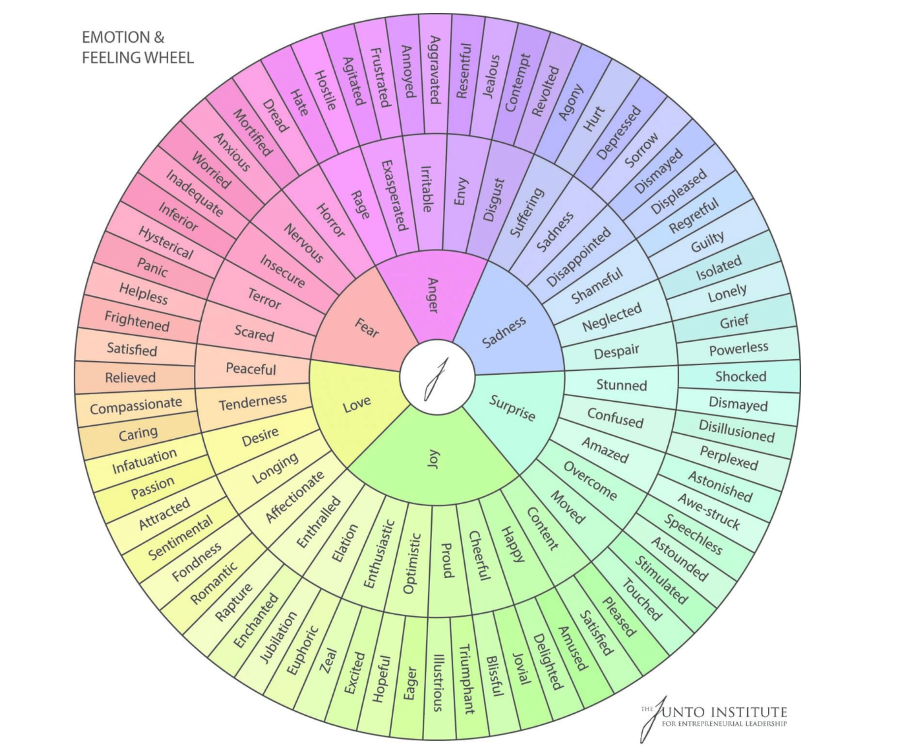"What words do you regularly use to describe your emotions?" is one of my favourite questions in the "emotions" category.
The neuroscience behind this is that "when your brain constructs an emotion, it considers information from your body state and context and labels that feeling with a word." Having a rich and varied emotional vocabulary is key.
Expanding your emotional literacy
Expanding emotional literacy, or the ability to identify, understand, and manage emotions in oneself and others, can be achieved through a variety of approaches.
Here are some ideas to cultivate emotional literacy:
1. Expand Emotional Vocabulary
- Learn and Practice New Emotion Words: Become familiar with a wide range of words beyond just "happy," "sad," or "angry." Examples include frustrated, anxious, elated, and "disillusioned. This allows for more precise emotional expression.
- Use Emotion Wheels: Tools like the "emotion wheel" categorise emotions into primary, secondary, and tertiary levels, helping to deepen emotional awareness. Check out this version of the emotion and feeling wheel.
- Read, read, read; generally for expanded vocabulary, and specifically for emotional expansion with books such as Words from the Heart (Susie Dent), Emotional Agility (Susan David) or Atlas of the Heart (Brene Brown).
2. Mindfulness and Self-Reflection
- Daily Emotional Check-Ins: Set aside time each day to reflect on how you feel and why. Journaling emotions and their causes can develop greater self-awareness. See here for more information on "morning pages", a beautifully simple way to journal.
- Mindfulness Practices: Engage in activities like meditation, breathing exercises, or yoga to stay present and become more attuned to your emotional state.
3. Practice Active Listening
- Listen for Emotions in Conversations: When interacting with others, focus not just on their words but on the emotions behind them. This helps you better understand and empathise with their emotional states.
- Validate Emotions: Acknowledge and validate the emotions of others by saying things like, “It sounds like you’re feeling frustrated,” to help build emotional connection.
4. Develop Empathy
- Perspective-Taking: Regularly practice putting yourself in others’ shoes. Consider how you would feel in their situation to build emotional insight. Dr Brene Brown has done some excellent work in this space. (Watch Brene Brown's video on empathy).
- Reading Fiction or Watching Films: Engage with stories that explore deep emotional experiences. This can enhance your ability to empathise with different emotions and situations.
5. Improve Emotional Regulation
- Identify Emotional Triggers: Learn what situations or behaviours trigger strong emotional responses in you, and reflect on why that happens.
- Use Emotional Regulation Techniques: Techniques such as cognitive reframing, pausing before reacting, or expressing emotions constructively can help manage challenging emotions effectively.
6. Seek Feedback from Others
- Ask for Input on Your Emotional Impact: Encourage people you trust to provide feedback on how you handle emotions, especially in challenging situations.
- Participate in Group Settings: Being part of workshops, therapy, or emotional intelligence groups can foster greater awareness of your emotional impact on others.
7. Engage in Emotional Literacy Training
- Workshops or Courses: Attend emotional intelligence (EI) workshops or take online courses specifically designed to build emotional literacy skills.
- Coaching or Therapy: Working with a coach or therapist can help you explore your emotions in a safe and structured environment.
- Use the Neuro Nudges cards!!
8. Model Emotional Literacy for Others
- Share Your Emotions: Be open about your own emotional experiences in appropriate settings. By modelling emotional expression, you encourage others to do the same.
- Teach Emotional Literacy to Children: Helping children understand and express their emotions from an early age can develop emotional literacy in the next generation.
Which of these approaches would be most relevant to your current work or personal context? What else could be useful?
With thanks to https://www.davidhodder.com/emotion-and-feeling-wheel/ for the use of the image of the Feeling and Emotion Wheel.
